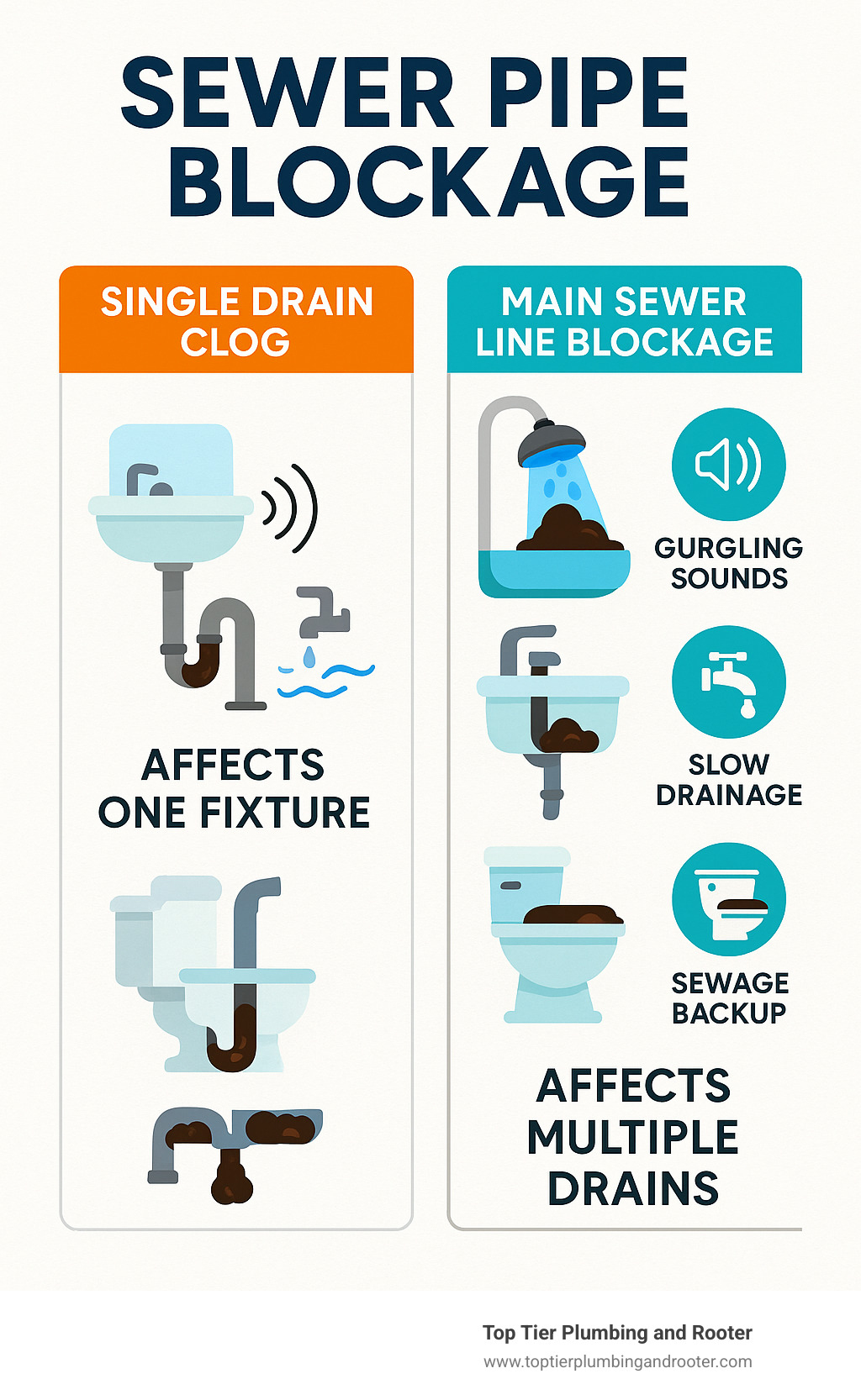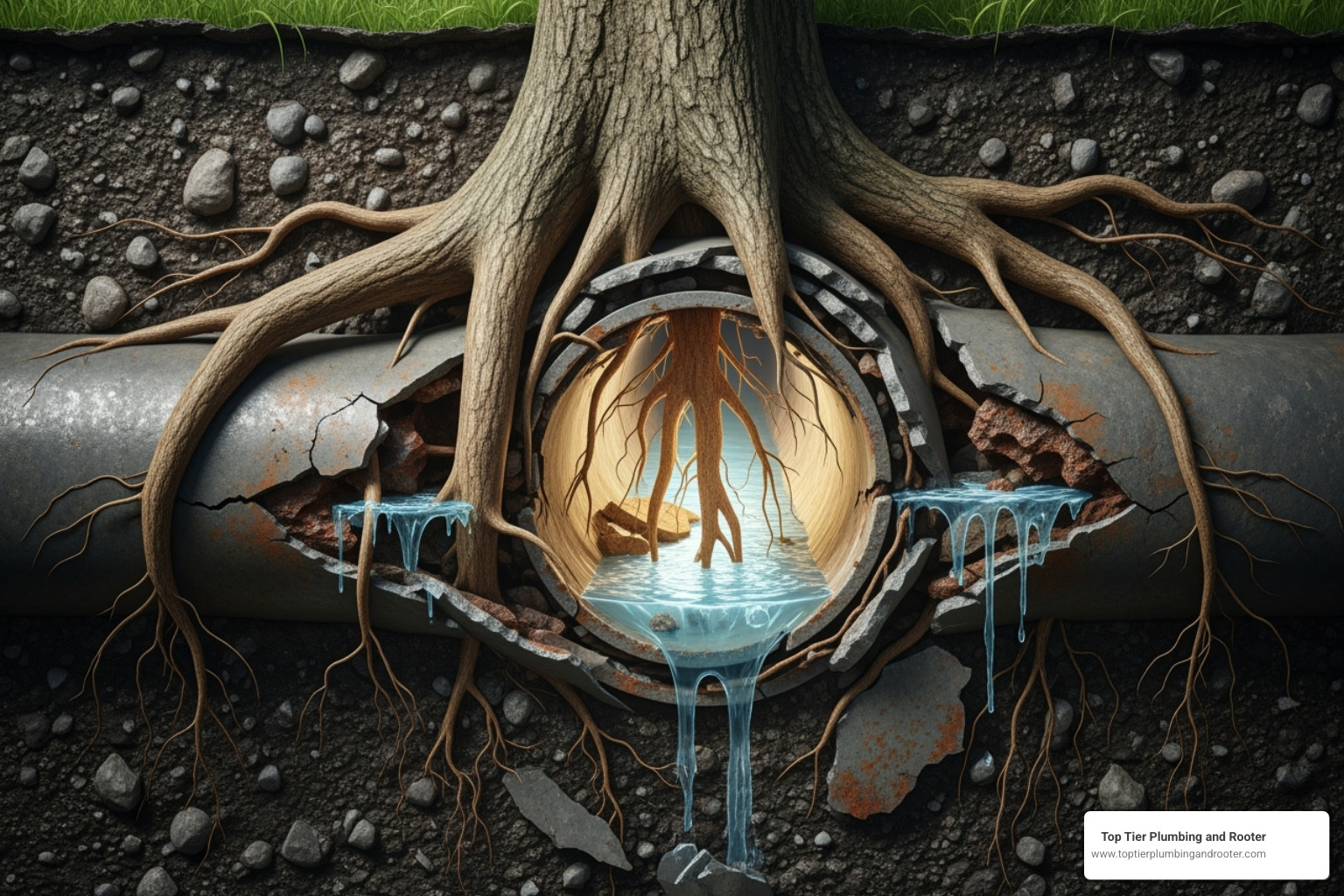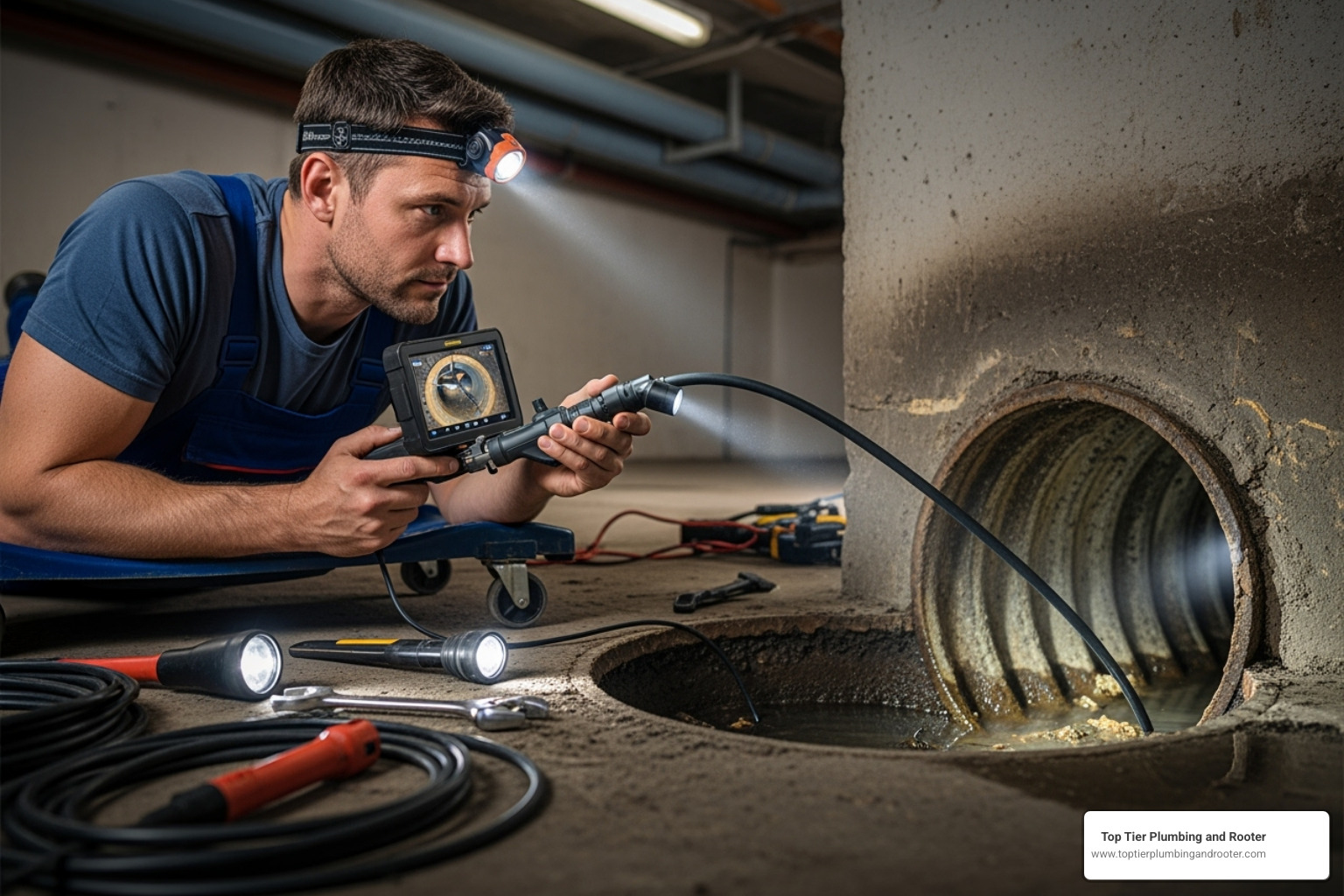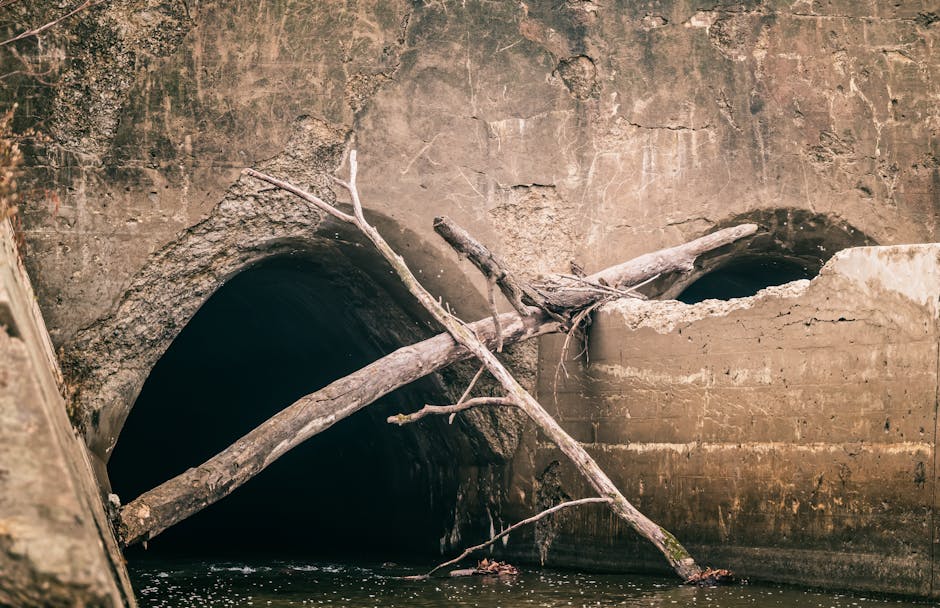Understanding Sewer Pipe Blockages: The Hidden Problem in Your Home
A sewer pipe blockage is a serious plumbing issue that can lead to backed-up toilets, foul odors, and potential health hazards. When your main sewer line clogs, it affects every drain in your house, from the kitchen sink to the bathroom shower.
Quick Answer: Key Signs of Sewer Pipe Blockage:
- Multiple drains backing up at the same time
- Gurgling sounds from toilets and drains
- Water backing up in unexpected places (like your shower when you flush the toilet)
- Foul sewage odors coming from drains
- Slow drainage throughout the house
Unlike a simple clog in a single drain, a main sewer line blockage impacts your entire home’s plumbing system. Think of your drains as branches on a tree and the main sewer line as the trunk; if the trunk is blocked, nothing can flow away properly.
Common causes include tree roots invading pipes, flushing items that don’t break down (like “flushable” wipes), grease buildup, and aging or damaged pipes. In Riverside and San Bernardino counties, tree root intrusion is a frequent problem. Fortunately, professional plumbers have specialized tools like video cameras and hydro-jetting equipment to diagnose and clear even the toughest blockages. Recognizing the warning signs early is key to acting fast.

The Telltale Signs: Is Your Main Sewer Line Clogged?
If you flush the toilet and water bubbles up in the shower, or running the laundry causes a sink to overflow, you’re likely dealing with a sewer pipe blockage. When the main line clogs, wastewater has nowhere to go and backs up into your home.
The biggest red flag is when multiple fixtures are affected at once. Your toilets, sinks, and showers will all drain slowly or back up because they share the same blocked main line. Strange gurgling sounds from your drains are another sign, caused by trapped air trying to escape past the obstruction. This often happens because your plumbing vents aren’t able to do their job properly. The most alarming symptom is water backups in unusual places, such as sewage coming up through a floor drain.
Differentiating a Minor Clog from a Main Line Blockage
A single drain issue, like a slow bathroom sink, usually points to a localized clog from hair or soap buildup. These can often be resolved with simple methods. However, a multiple drain issue affecting your toilet, shower, and sink simultaneously is a strong indicator of a main line blockage. When every drain in your home is sluggish, the problem lies in the main sewer line.
For a definitive confirmation, try the washing machine test. Washing machines discharge a large volume of water quickly. If running a load causes other drains to back up, your main sewer line can’t handle the flow, confirming a significant blockage. To learn more about causes, see our guide on why sewer lines get clogged.
Immediate Steps for a Suspected Sewer Pipe Blockage
If you suspect a main line blockage, act quickly to prevent a sewage overflow.
- Stop using water immediately. Don’t run faucets, flush toilets, or use appliances that drain water.
- Shut off your main water supply. This prevents accidental water use. The shut-off valve is usually in a basement, garage, or outside near the water meter.
- Locate your sewer cleanout. This is a capped pipe outside your home that provides direct access to the sewer line. It’s often a white pipe with a rubber or metal cap.
If you see sewage coming out of the cleanout, it confirms a main line blockage. For more tips, read our emergency plumbing guide.
The Dangers of Ignoring a Sewer Pipe Blockage
Ignoring a blocked sewer line can lead to severe consequences for your home and health.
- Property Damage: Raw sewage can destroy flooring, drywall, furniture, and personal belongings. The cleanup and restoration process is often extensive.
- Health Hazards: Sewage contains harmful bacteria, viruses, and pathogens that can cause serious illnesses. Studies have linked drainage issues to sanitation-related disease outbreaks.
- Mold Growth: The moisture left behind by a sewage backup creates ideal conditions for mold, which can damage property and trigger allergies and respiratory problems.
- Pest Infestation: Sewage backups attract rodents and insects, which can spread disease and create further sanitation issues.
A sewer pipe blockage is an emergency that requires immediate attention. The longer you wait, the greater the risk. Learn more about the hidden dangers of ignoring drainage issues.
Common Culprits: What Causes a Sewer Pipe Blockage?
A sewer pipe blockage typically occurs when improper items are sent down the drain or when the pipe itself is damaged. Most blockages are preventable once you understand the common causes.
Grease and fat buildup is a primary offender. When hot grease is poured down a drain, it cools and solidifies inside the pipes, creating a sticky coating that traps food particles, hair, and other debris. Over time, this accumulation can completely block the line.
Food waste, even from a garbage disposal, can cause issues. Starchy foods like pasta and rice expand in water, forming a thick paste. Eggshells and coffee grounds don’t dissolve and can build up like sediment.
Foreign objects are another frequent cause. Items like children’s toys, jewelry, or excessive amounts of toilet paper can easily create a clog. The most notorious culprits are products marketed as “flushable” wipes. These wipes do not break down like toilet paper and can create massive, stubborn blockages. Similarly, feminine hygiene products and paper towels are designed to be absorbent and should never be flushed.
Pipe damage can also lead to blockages. Shifting soil can cause pipes to crack or develop sagging lines (low spots) where debris collects. Scale buildup from hard water can also create rough surfaces that snag waste. For more prevention tips, see our guide on Drain Clog Prevention and Cleaning.
The Truth About Tree Root Intrusion
Your beautiful trees may be the source of your sewer problems. Tree root intrusion is a destructive and common cause of sewer pipe blockage, especially in areas with mature landscaping like Riverside and San Bernardino counties.

Tree roots are naturally drawn to the moisture and nutrients in your sewer line. They can enter through the smallest crack or loose pipe joint. Older pipes, particularly clay pipes with deteriorating joints, are highly vulnerable. Once inside, the roots expand, forming dense masses that trap waste and can eventually cause the pipe to collapse. Early detection through professional maintenance is the best way to prevent this. Learn how to protect your property in our guide: Plumbing Under Siege: Defending Your Pipes from Invasive Roots in Riverside and San Bernardino County.
What Not to Flush or Pour Down the Drain
Preventing a sewer pipe blockage starts with being careful about what goes down your drains. Only human waste and toilet paper should be flushed. Everything else is a potential clog.
- Fats, Oils, and Grease (FOG): These solidify in pipes and create stubborn clogs. Pour cooled grease into a container and throw it in the trash.
- “Flushable” Wipes: They do not break down and are a leading cause of major sewer blockages. Always dispose of them in the trash.
- Paper Towels and Tissues: Unlike toilet paper, these are designed to stay strong when wet and will not dissolve in your pipes.
- Feminine Hygiene Products: These are designed to be absorbent and will expand, causing severe blockages.
- Coffee Grounds and Eggshells: They don’t dissolve and accumulate over time, contributing to clogs.
- Hair: It combines with soap scum to form tough, rope-like clogs. Use drain strainers in showers and sinks.
- Other Items: Never flush dental floss, cotton swabs, cotton balls, or medications.
Being mindful of your drains is especially important during holidays. For more tips, visit Thanksgiving Plumbing Tips: How to Avoid Clogs and Kitchen Disasters.
Clearing the Way: Professional Solutions for Stubborn Blockages
When facing a main sewer pipe blockage, DIY methods are often ineffective and can even cause more damage. Main sewer lines run deep underground and contain blockages from tree roots or years of buildup that require specialized equipment and expertise.

Professional diagnosis is crucial for both safety and effectiveness. Working with sewer lines involves exposure to harmful bacteria, and using the wrong technique can damage your pipes, leading to more expensive repairs. For these reasons, it’s always best to call a professional for main line issues. Learn more at The Hidden Dangers of DIY Plumbing: Why You Should Hire a Professional.
Diagnostic and Cleaning Methods
Before tackling a sewer pipe blockage, professionals first diagnose the problem.
- Video Camera Inspection: A high-definition camera is fed into the sewer line to pinpoint the exact location and cause of the blockage. This eliminates guesswork and prevents unnecessary digging. This technology is a game-changer for sewer and drain repair.
- Drain Snaking (Auger): A professional-grade motorized snake with a rotating cutting head can break apart stubborn clogs, slice through tree roots, and clear the line.
- Hydro-Jetting: This method uses high-pressure water (up to 4,000 PSI) to scour the inside of pipes, completely removing grease, scale, and debris. It not only clears the immediate blockage but also helps prevent future ones by cleaning the entire pipe wall. Hydro-jetting is often the superior method of drain cleaning.
Repair and Replacement Options
If a camera inspection reveals damaged pipes, modern technology offers several solutions that minimize disruption to your property.
- Trenchless Sewer Repair: Methods like pipe lining (installing a new pipe inside the old one) and pipe bursting (pulling a new pipe through the old one) can repair lines without extensive digging. These techniques are faster, less invasive, and preserve your landscaping and driveway. Learn about the benefits of trenchless sewer repair.
- Traditional Excavation: In cases of complete pipe collapse or extensive damage, digging a trench may be necessary. Modern equipment makes this process more precise than in the past.
Homeowner vs. City: Who is Responsible?
Determining responsibility for a sewer pipe blockage depends on its location.
- Your Responsibility: The sewer lateral (the pipe running from your house to the property line) is the homeowner’s responsibility.
- City’s Responsibility: The city main (the large sewer line under the street) is the city’s responsibility.
- Service Connection: The connection point between your lateral and the city main may be a shared responsibility, depending on your municipality.
A simple rule of thumb: if only your house has a problem, the issue is likely on your property. If your neighbors are also experiencing backups, it’s probably a city main issue. We can help identify the blockage’s location and determine who is responsible. For more on this, see our guide to addressing urgent sewage issues.
An Ounce of Prevention: How to Avoid Future Blockages
The best way to deal with a sewer pipe blockage is to prevent it from happening in the first place. Simple preventative habits can save you from the stress and expense of a sewage backup. Think of it like routine car maintenance; a little care goes a long way in keeping your plumbing system healthy.
Key prevention strategies include:
- Proper Disposal Habits: Be mindful of what goes down your drains. Your toilet and sinks are not trash cans.
- Using Drain Strainers: These inexpensive mesh screens catch hair and food debris before they enter your pipes.
- Mindful Flushing: Educate your household that only human waste and toilet paper should be flushed.
Most preventative measures are simple habits, not expensive projects. For more tips, check out The Best Ways to Prevent Clogged Drains in Your Kitchen and Bathroom.
The Role of Professional Maintenance
While daily habits are vital, professional maintenance offers an essential layer of protection for your sewer lines.
Scheduled drain cleaning, such as hydro-jetting every 18-24 months, removes the gradual buildup of grease, soap scum, and minerals. Routine video camera inspections are also crucial, especially for homes with older pipes or mature trees. Early detection allows us to spot small cracks or root intrusion before they cause a major sewer pipe blockage, saving you from a costly emergency repair. This proactive approach provides peace of mind and protects your home. Learn more about the importance of professional drain cleaning.
Smart Habits for a Healthy Plumbing System
Adopt these smart habits to keep your plumbing running smoothly:
- Avoid Chemical Cleaners: Harsh chemicals can damage pipes and often fail to clear main line blockages. They can even make clogs worse. It’s always safer and more effective to call a professional. Read more on why you should avoid commercial drain cleaners.
- Run Hot Water: After washing greasy dishes, run hot water for a minute to help flush any residual grease down the line before it solidifies.
- Proper Garbage Disposal Use: Use your disposal for small food scraps only and always run cold water during and after use. Avoid fibrous foods like celery and never put non-food items in it. If you have issues, see our guide on repairing a clogged garbage disposal.
Frequently Asked Questions about Sewer Blockages
Homeowners often have questions when facing a potential sewer pipe blockage. Here are answers to some of the most common concerns we hear in Riverside and San Bernardino counties.
What is a sewer cleanout and how is it used?
The sewer cleanout is a capped pipe in your yard that provides direct access to your main sewer line. It allows plumbers to insert video inspection cameras, drain snakes, or hydro-jetting equipment to diagnose and clear a sewer pipe blockage without digging up your yard or entering your home. If you see water or sewage backing up out of the cleanout, it’s a clear sign of a main line clog.
How can I tell if a clog is my responsibility or the city’s?
Responsibility depends on the clog’s location. As a homeowner, you are responsible for your “sewer lateral,” the pipe that runs from your house to your property line. The city is responsible for the main sewer line under the street. A simple test is to check with your neighbors. If they are also having drainage issues, the problem is likely with the city’s main. If it’s only your home, the blockage is probably on your property.
How often should I have my sewer lines inspected?
Inspection frequency depends on several factors.
- Older Homes (pre-1980): We recommend an inspection every 2-3 years, as older pipes are more prone to damage.
- Homes with Mature Trees: Aggressive tree roots can invade pipes, so an annual or biennial inspection is wise to catch root intrusion early.
- Homes with a History of Clogs: If you’ve had past issues, more frequent inspections (every 6-12 months) can help prevent a recurrence.
- All Other Homes: For most homes, an inspection every 3-5 years provides good peace of mind and allows for early detection of potential problems before they become emergencies.
Your Partner in Plumbing Health
Facing a sewer pipe blockage is stressful, but you don’t have to handle it alone. At Top Tier Plumbing and Rooter, we understand that plumbing emergencies happen at the worst times, which is why we offer 24/7 availability for urgent sewer line problems.
Our team has served homeowners throughout Riverside County and San Bernardino County for years, building a reputation for getting the job done right the first time. We use specialized equipment to solve any blockage, from tree roots to years of buildup.
We are committed to upfront pricing and clear communication, so you won’t face any surprises. With same-day service and a 100% satisfaction guarantee, we stand behind our work. We know a backed-up sewer is more than an inconvenience—it’s a health hazard that needs immediate attention.
Don’t let a sewer pipe blockage disrupt your life. When you need reliable, professional help to protect your home’s plumbing system, we’re here for you.



